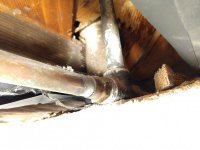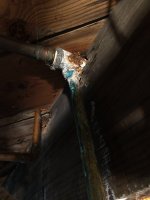Goodbar
New Member
I'm looking to avoid unexpectedly ripping apart my kitchen and bathrooms due to galvanic corrosion in my 1930s colonial. There are two galvanized Tees in the basement between copper pipes on the cold side only. One feeds the kitchen sink, with the other leg going to the laundry sink. The other is for the riser to the 2nd floor bathrooms, plus supply to the water heater.


The Tee for the kitchen has considerable external corrosion, but the other one looks fine. No problems with water pressure or flow anywhere.
After some web searching it looks like I could add dielectric unions or nipples, but there isn't a consensus that they actually work. If I were to add one or the other, I would move the laundry sink to a new Tee on the copper pipe and plug the galvanized Tee.
Suggestions on how to proceed (or abort!)? If I busted the kitchen Tee, I have reasonable confidence that I could run a new pipe as was done on the hot side. Not so for the riser, which would require access in the wall or ceiling.
Thanks


The Tee for the kitchen has considerable external corrosion, but the other one looks fine. No problems with water pressure or flow anywhere.
After some web searching it looks like I could add dielectric unions or nipples, but there isn't a consensus that they actually work. If I were to add one or the other, I would move the laundry sink to a new Tee on the copper pipe and plug the galvanized Tee.
Suggestions on how to proceed (or abort!)? If I busted the kitchen Tee, I have reasonable confidence that I could run a new pipe as was done on the hot side. Not so for the riser, which would require access in the wall or ceiling.
Thanks
